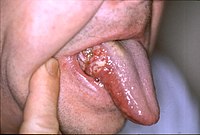
Photo from wikipedia
Background This study is aimed to assess the incidence of advanced opportunistic infections (OIs) and its predictors among Human Immunodeficiency Virus (HIV) infected children at Debre Tabor referral Hospital and… Click to show full abstract
Background This study is aimed to assess the incidence of advanced opportunistic infections (OIs) and its predictors among Human Immunodeficiency Virus (HIV) infected children at Debre Tabor referral Hospital and University of Gondar Compressive specialized Hospitals, Northwest Ethiopia, 2020. Methods A retrospective follow-up study was conducted from June 1, 2010, to May 30, 2020. A total of 349 children under the age of 15 who had received Anti-Retroviral Therapy (ART) were included in the study. Data were entered into Epi info version 7.2 and then exported to Stata 14.0 for analysis. Kaplan Meier curve and Log-rank test were used to determine the median survival time and the discrepancy of different categorical variables. The Cox regression model was used to identify the predictors of advanced opportunistic infections. The Adjusted hazard ratio (AHR) at 95% confidence interval (CI) was used to declare statistical significance. Result The incidence rate of advanced opportunistic infection was 5.53 per 100 (95% CI: 4.7, 6.9) Person per year observation (PYO). The median survival time was 113 months and the total follow-up periods were yielding 18882 months. Children presenting with treatment failure, Cotrimoxazole Preventive Therapy (CPT) non-user, low hemoglobin level (<10 mg/dl), and poor/fair level of adherence to ART were less free survival time as compared to their counterparts for advanced opportunistic infections. Conclusion In this study, the median of advanced OIs free survival time was found to be low and the incidence rate was found to be high. The incidence advanced OIs was associated with anemia, treatment failure, and poor/fair level of adherence, cotrimoxazole preventive therapy non-users. Further research should conduct to evaluate and to improve the quality of care in the study area.
Journal Title: Heliyon
Year Published: 2021
Link to full text (if available)
Share on Social Media: Sign Up to like & get
recommendations!